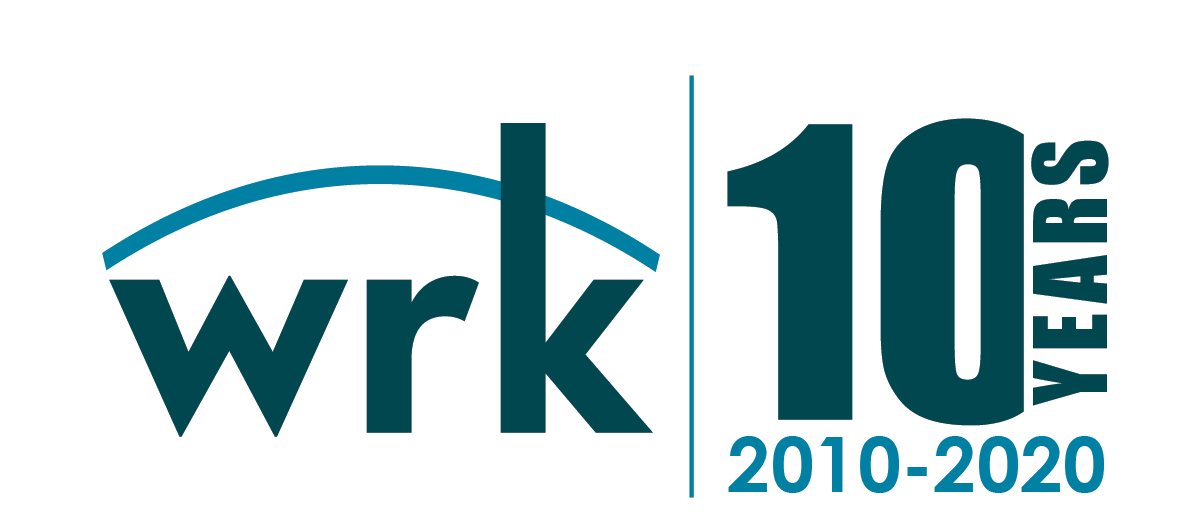Mexico City Earthquake Reconnaissance – Day 5
Central Mexico Earthquake Reconnaissance – Day 5

Today was my last day in Mexico City, but Team 2 (Infrastructure focus) from Reid Middleton would be staying for another few days. There were also several other teams of engineers from the U.S. that were actively doing earthquake reconnaissance as well. Teams from EERI (Earthquake Engineering Research Institute), GEER (Geotechnical Extreme Events Response), and Degenkolb Engineers. We met for dinner last night with the Degenkolb group to trade notes, share information and learn from each other. It was a great experience for several reasons. First of all, everyone spoke English and, as a non-Spanish speaker, this was great! But more importantly, collaborating with other professionals who are passionate about learning from earthquakes and observing the recovery process is energizing to me. There is simply too much geography to cover in Mexico City and surrounding areas in just 5 days for any one team, so sharing our experiences helped to fill in the information gaps we had. Through EERI, this process continues even as we are all back in the US.
Reflections
As I look back on my time in Mexico City, there are numerous take-aways for me, both technical and non-technical. What struck me the most was the response of the people. The resilience, determination, stamina and gratitude. For example, we visited a building collapse site in the La Condesa neighborhood earlier in the week. There were hundreds of people involved with the recovery efforts at the collapse site. It looked very organized, but I was surprised to learn that nearly everyone there was a volunteer that had come to help. The response was organic and grew from concerned neighbors, friends, family and fellow Mexicans. People from across Mexico City, as well as people from other parts of Mexico and even other nations (France, Israel, Brazil), came to help. For each of the recovery workers actively searching the collapse site, there were many more people in support roles. We were there nearly two weeks after the collapse and some people we spoke with had been there the entire time. Relentless.
There were also several instances of people thanking us just for showing up. From the group of school children handing out cookies (see Day 2 report) to an elderly lady who thanked us for just looking at her building, these brief encounters will stay with me. Even though we were not actively part of the search, recovery or repair process, I was surprised at the gratitude and friendliness the local people expressed when they saw us in hardhats and neon orange vests. Maybe our presence simply gave them reassurance that “official” looking engineers were there to help.
Signs of Resilience
To me resiliency is a time measurement of how quickly systems (such as cities) impacted by external forces (such as earthquakes) absorb, respond and restore life to “normal” (i.e. pre-event conditions). Resiliency includes pre-disaster mitigation (i.e. building/infrastructure strengthening), pre-disaster preparation (i.e. plans for responding) and post-disaster response (i.e. rescue, recovery and rebuilding). Ideally, the built environment has high enough resilience such that the time required to restore life to “normal” is very short (days or weeks).
During our trip we observed clear signs of low resiliency, such as damaged or collapsed buildings and broken infrastructure. These items are easy to spot and broadcast on news media very quickly. But there were also many signs of high resiliency too.
After the 1985 earthquake, Mexico invested in a network of earthquake detection sensors and an early warning system to provide real-time alerts when earthquakes happen. Our understanding is that early warning sirens in Mexico City blasted for at least 20 seconds before the strong shaking started. For the buildings that suffered either partial or total collapse, I assume this warning system likely saved lives, particularly people who were close to building exits and could make it out safely before the strong shaking started.
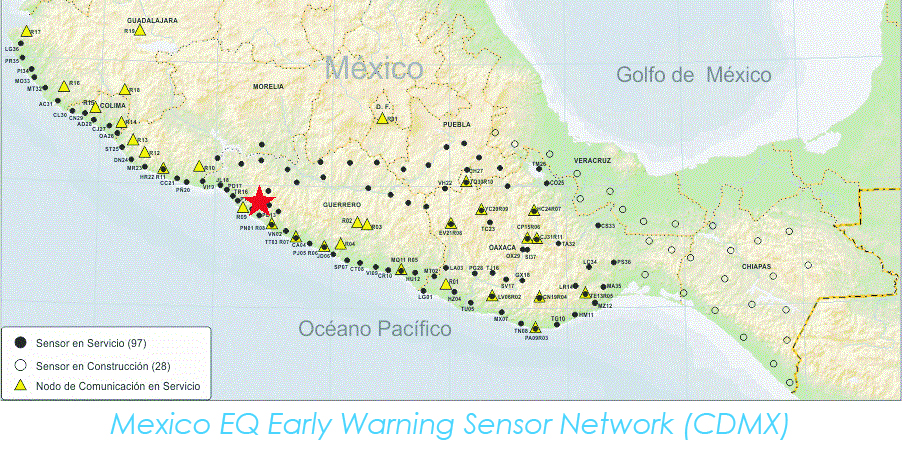
But we learned that several bodies were recovered in the stairwell at the La Condesa building collapse (mentioned in Day 2 report). Perhaps if these stairwells were designed and constructed as stronger “areas of refuge”, these lives could have been saved even as the building around them collapsed. The early warning system gave these people enough time to reach the stairwell, but sadly they couldn’t make it any further. One possible mitigation idea is, if seismic strengthening of buildings is too costly, then just strengthening the stairwells with intent to provide “area of refuge” that occupants could get to prior to strong shaking might be feasible.
Another sign of high resilience was the action taken to provide fresh water. SACMEX mobilized a multitude of water trucks for delivery of water to the millions of Mexico City residents left without a fresh water supply after the event. The Director General of the Water System of the Mexico City, Ramon Aguirre Diaz, reported that SACMEX was distributing over 6 million gallons of fresh drinking water per day to Mexico City residence. This is amazing. Although the water system network is not highly resilient, the post-earthquake response seemingly was.

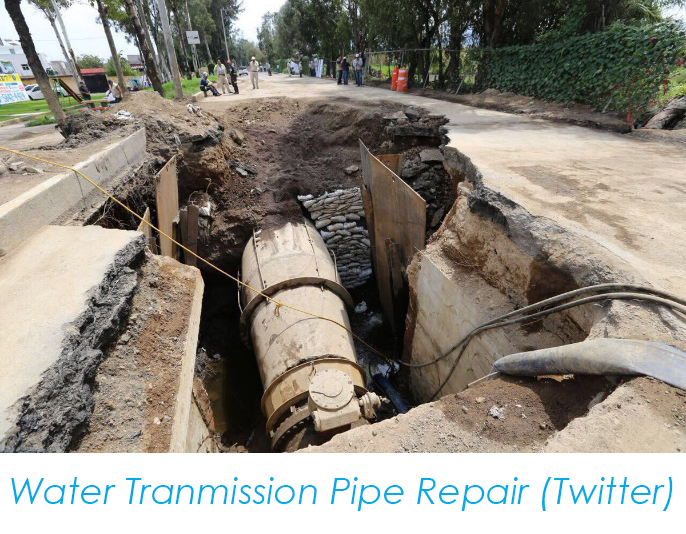 There are many areas of Mexico City that have inconsistent water supply on a regular basis. This is primarily due to the very poor soil conditions in Mexico City. In some areas of Mexico City, the ground is actually sinking at a rate of close to 1 foot per year! It’s easy to understand why buried systems, such as water and sewer, have areas of unreliable supply. However, as I mentioned in my Day 3 report, SACMEX is working 24 hour shifts to restore water service. The activation of manpower and materials in response to this event is impressive.
There are many areas of Mexico City that have inconsistent water supply on a regular basis. This is primarily due to the very poor soil conditions in Mexico City. In some areas of Mexico City, the ground is actually sinking at a rate of close to 1 foot per year! It’s easy to understand why buried systems, such as water and sewer, have areas of unreliable supply. However, as I mentioned in my Day 3 report, SACMEX is working 24 hour shifts to restore water service. The activation of manpower and materials in response to this event is impressive.
Technical Take-Aways
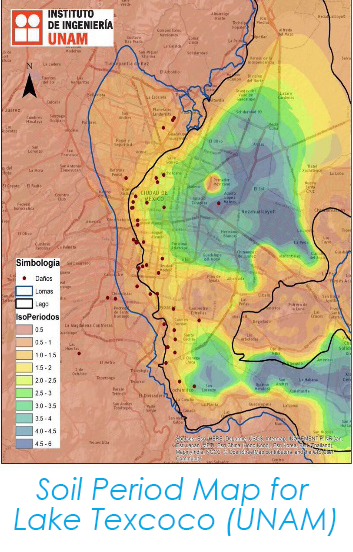 For me the most interesting aspect of this earthquake is the soil amplification of ground shaking and the impact on building response. Going back to the building damage map published by UNAM (National Autonomous University of Mexico) which shows on outline of the ancient Lake Texcoco shoreline along with reported damaged buildings. In addition, the map identifies approximate fundamental periods for the ancient lakebed soils. I assume the soil period is primarily proportional to the depth of soil column above bedrock.
For me the most interesting aspect of this earthquake is the soil amplification of ground shaking and the impact on building response. Going back to the building damage map published by UNAM (National Autonomous University of Mexico) which shows on outline of the ancient Lake Texcoco shoreline along with reported damaged buildings. In addition, the map identifies approximate fundamental periods for the ancient lakebed soils. I assume the soil period is primarily proportional to the depth of soil column above bedrock.
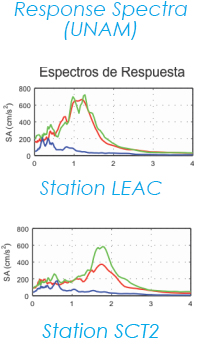 It’s interesting that a significant number of the collapsed buildings occur at shallow lakebed soil locations with soil fundamental periods between 1 sec & 2 sec. This is reinforced by plots of spectral accelerations vs. period developed by UNAM for various stations across Mexico City. These plots show spikes in the spectra response in the 1 to 2 second period domain.
It’s interesting that a significant number of the collapsed buildings occur at shallow lakebed soil locations with soil fundamental periods between 1 sec & 2 sec. This is reinforced by plots of spectral accelerations vs. period developed by UNAM for various stations across Mexico City. These plots show spikes in the spectra response in the 1 to 2 second period domain.
Further, we found information, published by Crowley and Phiho (2006), that estimates the period of vibration (in sec.) for reinforced concrete frames with cracked masonry infill to be T = 0.055H with H = total building height. Running the simple calculations, assuming a typical 10-foot story height, buildings with a fundamental period between 1 sec & 2 sec occur in the 6 to 12 story range. Our understanding is that most of the collapsed buildings were in this mid-rise range.
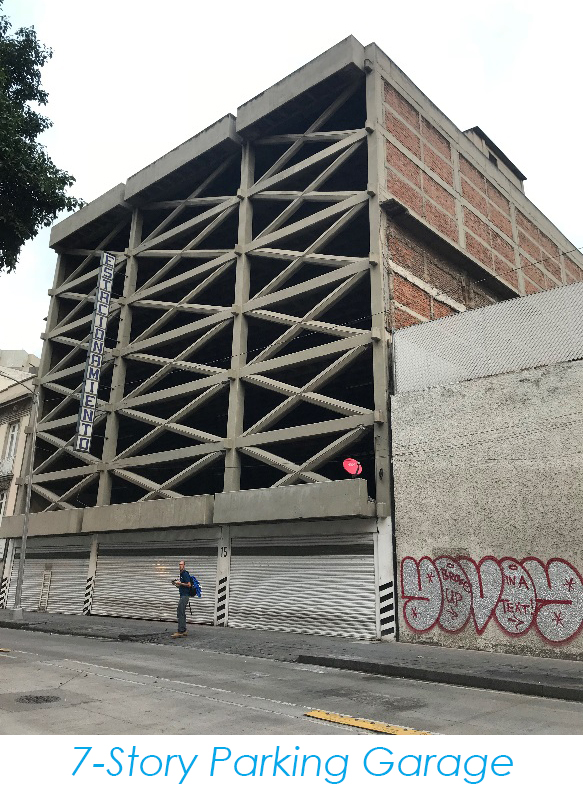
Essentially, in the period range of 1 to 2 seconds, the soil vibration was in resonance with the fundamental building period, causing significant building structural response. For an example, go look up the Tacoma Narrow Bridge Collapse for an example of what happens when structures are excited in their fundamental, or resonance, period for many cycles. Not good. Due to these amplification effects, the Mexico City basin is a truly unique geological setting and results in high seismic demands on the built environment.
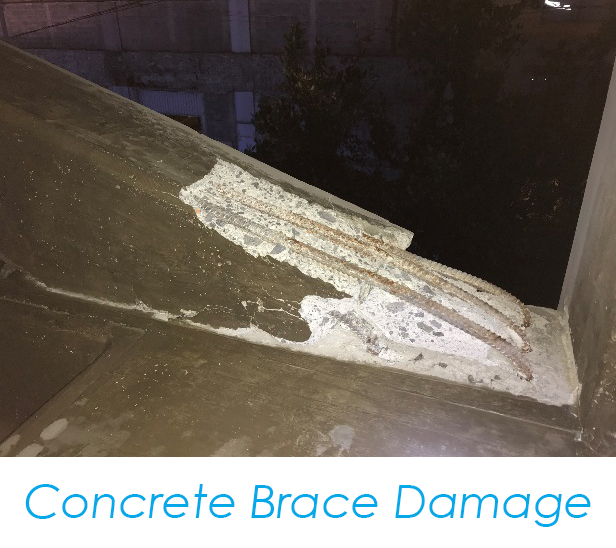 Additional take-aways included confirmation that good earthquake design should avoid the use lateral force resisting system layouts that include structural irregularities, such as discontinuous shear walls or braces, highly torsional layout of shear walls, soft stories, weak stories and short/captured columns. It was readily apparent to me the need for ductile detailing requirements of reinforced concrete members with tight spacing of confining reinforcement (i.e. column ties) and adequate lap splice lengths and locations.
Additional take-aways included confirmation that good earthquake design should avoid the use lateral force resisting system layouts that include structural irregularities, such as discontinuous shear walls or braces, highly torsional layout of shear walls, soft stories, weak stories and short/captured columns. It was readily apparent to me the need for ductile detailing requirements of reinforced concrete members with tight spacing of confining reinforcement (i.e. column ties) and adequate lap splice lengths and locations.
Why go look at earthquake damage?
 At WRK Engineers, our corporate purpose is “To make a difference worldwide by designing resilient structures that protect lives”. As such, we are passionate about understanding seismic performance of buildings and infrastructure. We follow this passion through life-long learning so that we can be the best resource for our clients and engineering community. Part of our mission is to not just make buildings safer, but better than safe. Resilient.
At WRK Engineers, our corporate purpose is “To make a difference worldwide by designing resilient structures that protect lives”. As such, we are passionate about understanding seismic performance of buildings and infrastructure. We follow this passion through life-long learning so that we can be the best resource for our clients and engineering community. Part of our mission is to not just make buildings safer, but better than safe. Resilient.
To me, one of the best ways to learn about earthquake behavior of the built environment is to see first-hand how engineered systems performed. Essentially, earthquakes result in a giant laboratory of test subjects that are each unique in size, shape, configuration and construction. Each building is different and unique and provides a learning opportunity in terms of figuring out how it was damaged and why.

Learning from earthquakes has formed the backbone of modern seismic design practice and will continue to do so with each subsequent event. So in essence, we visit earthquakes to learn, to improve, and to grow.
 We also visit earthquake damaged area to help. As professional engineers we have a duty to serve public with our skills, abilities and expertise. The NSPE (National Society of Professional Engineers) Code of Ethics includes “…engineers…must be dedicated to the protection of the public health, safety, and welfare”. Showing up at earthquake damaged areas and assisting with building safety assessments is critical to the local restoration efforts. Giving people assurance that their home, school or place of business is safe to re-enter after a major earthquake is essential to beginning the process of returning life to “normal”.
We also visit earthquake damaged area to help. As professional engineers we have a duty to serve public with our skills, abilities and expertise. The NSPE (National Society of Professional Engineers) Code of Ethics includes “…engineers…must be dedicated to the protection of the public health, safety, and welfare”. Showing up at earthquake damaged areas and assisting with building safety assessments is critical to the local restoration efforts. Giving people assurance that their home, school or place of business is safe to re-enter after a major earthquake is essential to beginning the process of returning life to “normal”.
Finally, I would like to thank the people at Reid Middleton for allowing me to join their earthquake investigation team. Their willingness to include me on their team and share information, resources, knowledge in a collaborative manner was great. The Reid Middleton team included David Gonzalez, David Swanson, Erik Bishop, Nicole Trujillo, Darin Aveyard, Kenny O’Neil, Kevin Galvez, and Drew Nielson. Also, part of our group was Dr. Erica Fischer (Asst. Professor, Oregon State University) and Mark Pierepiekarz (President, MRP Engineering). These professionals are all passionate about earthquake safety and without these great people I would not have been able have this experience. Thank you.
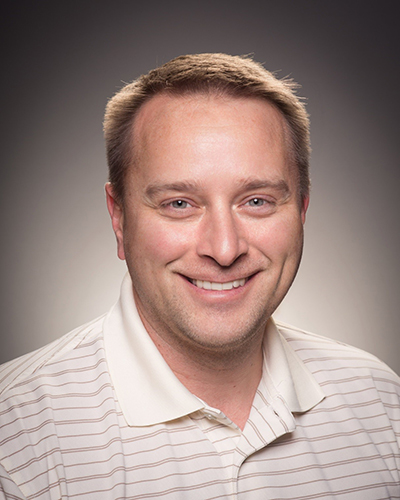
Brian Knight, P.E., S.E.
Founder and Principal of WRK Engineers, a Structural & Seismic Engineering consulting firm that is in the business of solving structural and seismic problems with adaptive solutions that protect and preserve people and assets.
Thank you for reading my observations from Mexico City. If you have questions or comments, please go to our Contact page. I would love to get your input.
